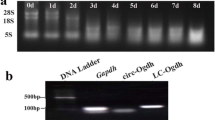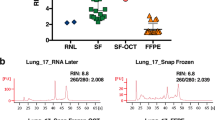Abstract
Messenger RNA (mRNA) profiling in post-mortem human tissue might reveal information about gene expression at the time point of death or close to it. When working with post-mortem human tissue, one is confronted with a natural RNA degradation caused by several parameters which are not yet fully understood. The aims of the present study were to analyse the influence of impaired RNA integrity on the reliability of quantitative gene expression data and to identify ante- and post-mortem parameters that might lead to reduced RNA integrities in post-mortem human brain, cardiac muscle and skeletal muscle tissues. Furthermore, this study determined the impact of several parameters like type of tissue, age at death, gender and body mass index (BMI), as well as duration of agony, cause of death and post-mortem interval on the RNA integrity. The influence of RNA integrity on the reliability of quantitative gene expression data was analysed by generating degradation profiles for three gene transcripts. Based on the deduced cycle of quantification data, this study shows that reverse transcription quantitative polymerase chain reaction (RT-qPCR) performance is affected by impaired RNA integrity. Depending on the transcript and tissue type, a shift in cycle threshold values of up to two cycles was observed. Determining RNA integrity number of 136 post-mortem samples revealed significantly different RNA qualities among the three tissue types with brain revealing significantly lower integrities compared to skeletal and cardiac muscle. The body mass index was found to influence RNA integrity in skeletal muscle tissue (M. iliopsoas). Samples originating from deceased with a BMI > 25 were of significantly lower integrity compared to samples from normal weight donors. Correct data normalisation was found to partly diminish the effects caused by impaired RNA quality. Nevertheless, it can be concluded that in post-mortem tissue with low RNA integrity numbers, the detection of large differences in gene expression activities might still be possible, whereas small expression differences are prone to misinterpretation due to degradation. Thus, when working with post-mortem samples, we recommend generating degradation profiles for all transcripts of interest in order to reveal detection limits of RT-qPCR assays.




Similar content being viewed by others
References
Stan AD, Ghose S, Gao XM, Roberts RC, Lewis-Amezcua K, Hatanpaa KJ, Tamminga CA (2006) Human postmortem tissue: what quality marker matters? Brain Res 1123:1–11
Bustin SA, Beaulieu JF, Huggett J et al (2010) MIQE précis: practical implementation of minimum standard guidelines for fluorescence-based quantitative real-time PCR experiments. BMC Mol Biol 11:74
Barton AJ, Pearson RC, Najlerahim A, Harrison PJ (1993) Pre- and post-mortem influences on brain RNA. J Neurochem 61:1–11
Durrenberger PF, Fernando S, Kashefi SN et al (2010) Effects of antemortem and postmortem variables on human brain mRNA quality: a BrainNet Europe study. J Neuropathol Exp Neurol 69:70–81
Tomita H, Vawter MP, Walsh DM et al (2004) Effect of agonal and postmortem factors on gene expression profile: quality control in microarray analyses of postmortem human brain. Biol Psychiatry 55:346–352
Preece P, Cairns NJ (2003) Quantifying mRNA in postmortem human brain: influence of gender, age at death, postmortem interval, brain pH, agonal state and inter-lobe mRNA variance. Brain Res Mol Brain Res 118:60–71
Vennemann M, Koppelkamm A (2010) mRNA profiling in forensic genetics I: possibilities and limitations. Forensic Sci Int 203(1–3):71–75
Bustin SA (2002) Quantification of mRNA using real-time reverse transcription PCR (RT-PCR): trends and problems. J Mol Endocrinol 29:23–39
Bonini JA, Hofmann C (1991) A rapid, accurate, nonradioactive method for quantitating RNA on agarose gels. Biotech 11:708–710
Schneeberger C, Speiser P, Kury F, Zeillinger R (1995) Quantitative detection of reverse transcriptase-PCR products by means of a novel and sensitive DNA stain. PCR Methods Appl 4:234–238
Sambrook J, Fritsch EF, Maniatis T (1989) Molecular cloning: a laboratory manual, 2nd edn. Cold Spring Harbor Laboratory Press, New York
Baelde HJ, Cleton-Jansen AM, van Beerendonk H, Namba M, Bovée JV, Hogendoorn PC (2001) High quality RNA isolation from tumours with low cellularity and high extracellular matrix component for cDNA microarrays: application to chondrosarcoma. J Clin Pathol 54:778–782
Imbeaud S, Graudens E, Boulanger V et al (2005) Towards standardization of RNA quality assessment using user-independent classifiers of microcapillary electrophoresis traces. Nucleic Acids Res 33:e56
Weis S, Llenos IC, Dulay JR, Elashoff M, Martínez-Murillo F, Miller CL (2007) Quality control for microarray analysis of human brain samples: the impact of postmortem factors, RNA characteristics, and histopathology. J Neurosci Methods 165:198–209
Mueller O, Hahnenberger K, Dittmann M, Yee H, Dubrow R, Nagle R, Ilsley D (2000) A microfluidic system for high-speed reproducible DNA sizing and quantitation. Electrophoresis 21:128–134
Bustin SA, Benes V, Garson JA et al (2009) The MIQE guidelines: minimum information for publication of quantitative real-time PCR experiments. Clin Chem 55:611–622
Fleige S, Walf V, Huch S, Prgomet C, Sehm J, Pfaffl MW (2006) Comparison of relative mRNA quantification models and the impact of RNA integrity in quantitative real-time RT-PCR. Biotechnol Lett 28:1601–1613
Schroeder A, Mueller O, Stocker S et al (2006) The RIN: an RNA integrity number for assigning integrity values to RNA measurements. BMC Mol Bio 7:3–16
Atz M, Walsh D, Cartagena P et al (2007) Methodological considerations for gene expression profiling of human brain. J Neurosci Methods 163:295–309
Koppelkamm A, Vennemann B, Fracasso T, Lutz-Bonengel S, Schmidt U, Heinrich M (2010) Validation of adequate endogenous reference genes for the normalisation of qPCR gene expression data in human post mortem tissue. Int J Leg Med 124(5):371–380
Ho-Pun-Cheung A, Bascoul-Mollevi C, Assenat E et al (2009) Reverse transcription-quantitative polymerase chain reaction: description of RIN-based algorithm for accurate data normalization. BMC Mol Biol 10:31–41
Heinrich M, Matt K, Lutz-Bonengel S, Schmidt U (2007) Successful RNA extraction from various human postmortem tissues. Int J Legal Med 121:136–142
Hellemans J, Mortier G, De Paepe A, Speleman F, Vandesompele J (2007) qBase relative quantification framework and software for management and automated analysis of real-time quantitative PCR data. Genome Biol 8:R19
Fleige S, Pfaffl MW (2006) RNA integrity and the effect on the real-time qRT-PCR performance. Mol Aspects Med 27:126–139
Hsiao LL, Dangond F, Yoshida T et al (2001) A compendium of gene expression in normal human tissue. Physiol Genomics 7:97–104
Inoue H, Kimura A, Tuji T (2002) Degradation profile of mRNA in a dead rat body: basic semi-quantification study. Forensic Sci Int 130:127–132
Lee J, Hever A, Willhite D, Zlotnik A, Hevezi P (2005) Effects of RNA degradation on gene expression analysis of human post mortem tissues. FASEB J 19:1356–1358
Hardy JA, Wester P, Winblad B, Gezelius C, Bring G, Eriksson A (1985) The patients dying after long terminal phase have acidotic brains; implications for biochemical measurements on autopsy tissue. J Neural Transm 61:253–264
Ravid R, Van Zwieten EJ, Swaab DF (1992) Brain banking and the human hypothalamus—factors to match for, pitfalls and potentials. Prog Brain Res 93:83–95
Harrison PJ, Heath PR, Eastwood SL, Burnet PW, McDonald B, Pearson RC (1995) The relative importance of premortem acidosis and post mortem interval for human brain gene expression studies: selective mRNA vulnerability and comparison with their encoded proteins. Neursci Letters 200:151–154
Hynd MR, Lewohl JM, Scott HL, Dodd PR (2003) Biochemical and molecular studies using human autopsy brain tissue. J Neurochem 85:543–562
Webster MJ (2006) Tissue preparation and banking. Prog Brain Res 158:3–14
Mall G, Eisenmenger W (2005) Estimation of time since death by heat-flow finite-element model. Part I: method, model, calibration and validation. Leg Med (Tokyo) 7:1–14
Wittwer CT, Herrmann MG, Moss AA, Rasmussen RP (1997) Continuous fluorescence monitoring of rapid cycle DNA amplification. Biotech 22:134–138
Acknowledgements
The authors would like to extend their special thanks to Elke Troppmann (Institute of Human Genetics, Freiburg University) for the kind permission to use the Nanodrop machine and to Anja Schoepflin (Institute of Pathology, Freiburg University) for the kind permission to use the Bioanalyzer. We are also grateful to Prof. Dr. Dieter Hauschke, Institute of Biometry and Medical Statistics, Freiburg University, for statistical consulting, to Thomas Rost and Wolfgang Schmidt and the autopsy team in Muenster for their help with sample collection, as well as to Dr. Juliane Sanft (Institute of Legal Medicine, Jena University) for helpful comments on the manuscript. This work is part of A.K.’s Ph.D. thesis.
Author information
Authors and Affiliations
Corresponding author
Electronic Supplementary Material
Below is the link to the electronic supplementary material.
ESM Figure 1
Scatter plots with Pearson correlation (R) between the post-mortem interval (PMI) and RNA integrity numbers (RIN) observed in human post-mortem brain (n = 42), cardiac muscle (n = 43) and skeletal muscle (n = 41) tissue. Analysis was performed for samples with PMI < 50 h. Significances (p) were calculated using SPSS (DOC 110 kb)
ESM Figure 2
Box–whisker plots of RIN values according to the following parameters: a age at death, b gender, c duration of agony and d cause of death (DOC 119 kb)
ESM Table 1
Clinical information including cause of death, agony, gender, age at death, body mass index (BMI), post-mortem interval (PMI), collected tissue type and RIN number of the RNA sample for each of the 49 individuals included in this study (XLS 43 kb)
ESM Table 2
Mean cycles of quantification (C q) with standard deviation (SD) obtained from three assays (ACTB, B2M and 18S rRNA) for artificially degraded, commercially available total RNA from brain (A), heart (B) and skeletal muscle (C). Additionally, the total C q shifts between the highest and the lowest RIN values, respectively, are given. The Pearson correlation (R) significances (p) were calculated using SPSS (DOC 82 kb)
ESM Table 3
Pearson correlation (R) and significances (p) were calculated using SPSS to show correlations between RIN and non-normalised cycles of quantification (NN-C q) and calibrated normalised relative quantities (CNRQ), respectively. Data are given for all ten gene transcripts analysed in Koppelkamm et al. [20] for brain (A), cardiac muscle (B) and skeletal muscle (C) (DOC 56 kb)
Rights and permissions
About this article
Cite this article
Koppelkamm, A., Vennemann, B., Lutz-Bonengel, S. et al. RNA integrity in post-mortem samples: influencing parameters and implications on RT-qPCR assays. Int J Legal Med 125, 573–580 (2011). https://doi.org/10.1007/s00414-011-0578-1
Received:
Accepted:
Published:
Issue Date:
DOI: https://doi.org/10.1007/s00414-011-0578-1




